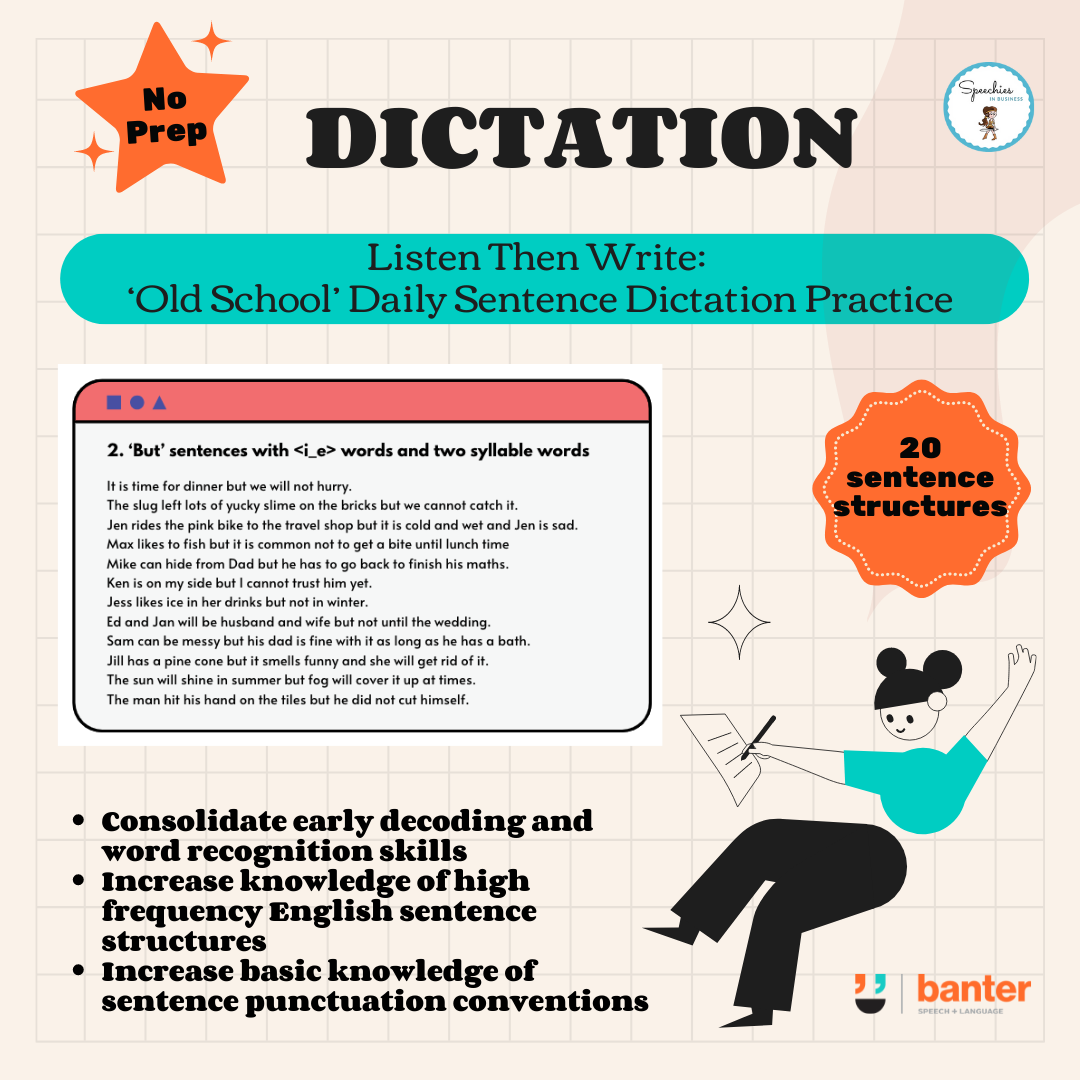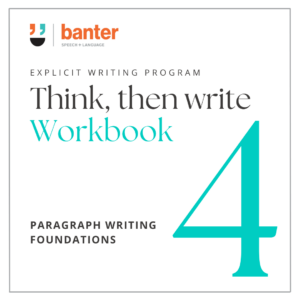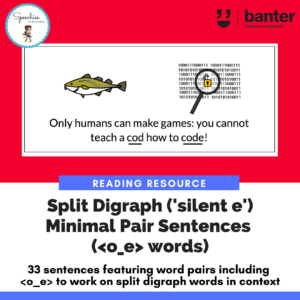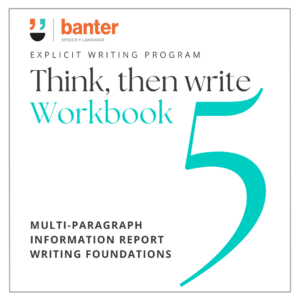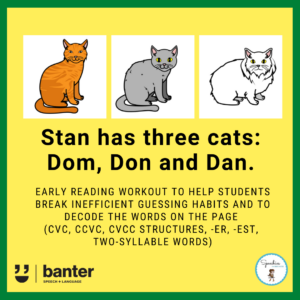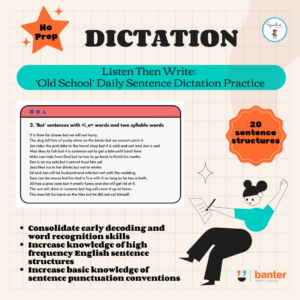(R219) Listen then Write: ‘Old School’ Daily Sentence Dictation Practice
$15.00 including GST
In this 25-page no-prep resource, we target three things at once:
-
- encoding (or spelling) targets that mirror decoding practice (e.g with decodable books);
- high frequency sentence structures used in English; and
- English sentence punctuation conventions.
Our encoding and sentence structure targets are sequenced from simple to complex:
-
- In Part A, we target simple sentence structures (like SV, SVO, SVC, SVA, and SVOA) requiring only knowledge of the basic code.
- In Part B, we target compound sentence structures (using decodable conjoining conjunctions like “and”, “but”, “yet”, and “so”) requiring knowledge of split digraphs, how to encode two-syllable (decodable) polysyllabic words.
- In Part C, we target complex sentence structures (using subordinating conjunctions, like “because”, “if”, “while”, “before”, “after”, “until”, “unless” “although”, and “otherwise”) and knowledge of high frequency extended code diphthongs and digraphs following the early Sounds Write sequence.
Description
‘Old school’ daily sentence dictation practice to:
-
- consolidate early decoding and word recognition skills;
- increase knowledge of high frequency English sentence structures; and
- increase basic knowledge of sentence punctuation conventions.
For 100s of years, dictation has been used to help students learn to read and write. But it’s fallen out of favour in recent years. We think that’s a shame.
Dictation practice has many benefits for early readers. For example, it:
-
- gives students practice encoding speech sounds into letters, words and sentences, helping to consolidate early decoding skills;
- allows students to hear words in the context of meaningful sentences, with semantic as well as orthographic and phonological connections;
- reinforces spelling, grammar and composition concepts;
- supports the teaching of sentence punctuation conventions, such as capital letters and full stops (periods) through procedural learning and feedback;
- combines oral language comprehension and writing activities;
- encourages students to participate actively;
- exposes students to a working memory load that is similar to that used when composing texts; and
- assists students to go beyond single word spelling to writing.
(See, for example: Robinson-Kooi and Hammond, 2020; Berninger and Richards, 2002; David and Rinvolucri, 1988.)
In this 25-page no-prep resource, we target three things at once:
-
- encoding (or spelling) targets that mirror decoding practice (e.g with decodable books);
- high frequency sentence structures used in English; and
- English sentence punctuation conventions.
Our encoding and sentence structure targets are sequenced from simple to complex:
-
- In Part A, we target simple sentence structures (like SV, SVO, SVC, SVA, and SVOA) requiring only knowledge of the basic code.
- In Part B, we target compound sentence structures (using decodable conjoining conjunctions like “and”, “but”, “yet”, and “so”) requiring knowledge of split digraphs, how to encode two-syllable (decodable) polysyllabic words.
- In Part C, we target complex sentence structures (using subordinating conjunctions, like “because”, “if”, “while”, “before”, “after”, “until”, “unless” “although”, and “otherwise”) and knowledge of high frequency extended code diphthongs and digraphs following the early Sounds Write sequence.
This resource can be used one-on-one or with groups and is designed to be paired with pre-teaching of the relevant sentence structure and spelling pattern or target.
Students can write their responses in a special dictation book or on a mini-white board using principles of direct instruction (including, e.g. “I say, we say, you say, you write, we read, you read).
This resource can be used for a “sentence a day” activity. It can also be used at higher doses to revise common spelling patterns, to mirror decoding practice.
More resources:
-
- For more sentence structure resources, check out our:
- simple sentence builders, e.g. Subject Verb Object sentences;
- compound sentence builders, e.g. compound conjunction ‘so’;
- complex sentence builders, e.g. subordinating conjunction ‘unless’;
- Think Then Write Foundations: Simple Sentence Writing Bundle (SV, SVO, SVC, SVA, SVOA, SVOO, SVOA sentence structures and compound sentences using conjunctions)
- Think, Then Write (Volume 1): A No-Prep Workbook To Write Complex Sentences; and
- Think, Then Write (Volume 2): A No-Prep Workbook To Write Paragraphs.
- For more early decoding practice using the basic code, check out our:
- For more practice reading reading sentences featuring decodable texts, check out our:
- For more practice reading decodable sentences featuring texts loaded with specific extended code targets, check out our:
- Scatterslayer Adventures for reluctant readers; and
- Extended Code sentence story reading exercises.
- For more sentence structure resources, check out our:

